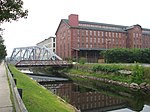Pemberton Mill
1853 establishments in Massachusetts1860 disasters in the United States1860 disestablishments in MassachusettsBuildings and structures demolished in 1860Buildings and structures in Lawrence, Massachusetts ... and 7 more
Collapsed buildings and structures in the United StatesDisasters in Lawrence, MassachusettsHistory of Essex County, MassachusettsIndustrial accidents and incidents in the United StatesIndustrial buildings completed in 1853January 1860 eventsTextile mills in the United States

The Pemberton Mill was a large factory in Lawrence, Massachusetts. It suddenly collapsed and occupants were crushed or burned alive on January 10, 1860, in what has been called "the worst industrial accident in Massachusetts history" and "one of the worst industrial calamities in American history." An estimated 88 to 145 workers were killed and 166 injured.Investigators attributed the disaster to substandard construction that was then drastically overloaded with second-floor equipment, all evident and preventable. The event was cited in improvements to industrial construction and workplace safety. The mill was soon rebuilt in place.
Excerpt from the Wikipedia article Pemberton Mill (License: CC BY-SA 3.0, Authors, Images).Pemberton Mill
Canal Street, Lawrence
Geographical coordinates (GPS) Address Nearby Places Show on map
Geographical coordinates (GPS)
| Latitude | Longitude |
|---|---|
| N 42.705555555556 ° | E -71.154444444444 ° |
Address
Pemberton Mill
Canal Street 216
01842 Lawrence
Massachusetts, United States
Open on Google Maps










